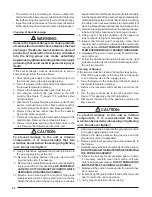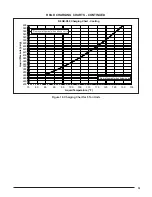
21
8. After the gas valve opens (30 seconds), the blower will
ramp to the selected airfl ow and continues to run.
9. When the thermostat has been satisfi ed, the W terminal
on the integrated control is de-energized.
10. The gas valve circuit is de-energized and the gas
vallve closes.
11. The inducer motor will continue to run for the post
purge period of 25 seconds.
12. The main blower will continue to run for the BLOWER
OFF delay of 135 seconds.
13. After the BLOWER OFF timer has been satisfi ed, the
integrated control de-energizes the main circulating
blower circuit.
Cooling Mode
1. On a call for cooling, the thermostat closes and applies
24 VAC to the green and yellow leads in the low voltage
area.
2. The green lead applies 24VAC to the G terminal of
the integrated control, energizing the main circulating
blower circuit at the cooling speed.
3. The yellow lead applies 24VAC to the contactor.
4. When the thermostat is satisfi ed, the contactor and
integrated control de-energize.
5. The circulating blower motor de-energizes after a 85-
90 second delay.
Fan Mode
1. On a call for fan operation, the thermostat applies 24
VAC to the green lead connected to the G terminal of
the integrated control.
2. The circulating blower is energized immediately at the
heating speed if 2-SPD is selected or fan only speed
if 3-SPD is selected on the control. NOTE: If a call for
heat occurs, the circulating blower de-energizes prior
to normal heating cycle.
EQUIPMENT MAINTENANCE
WARNING:
To avoid risk of electrical shock, personal injury,
or death, disconnect all electrical power to the unit
before performing any maintenance or service.
The unit may have more than one electrical supply.
Label all wires prior to disconnection when
servicing the unit. Wiring errors can cause
improper and dangerous operation
CAUTION:
Use care when removing parts from this unit.
Personal injury can result from sharp metal
edges present in all equipment of sheet metal
construction.
Proper maintenance is important to achieve optimum
performance from the system. The ability to properly
perform maintenance on this equipment requires certain
mechanical skills and tools. If you do not possess these
skills, contact your dealer for maintenance. Consult your
local dealer about the availability of maintenance contracts.
Routine maintenance should include the following:
CAUTION:
The unit should never be operated without a
fi lter in the return air system. Replace disposable
fi lters with the same type and size.
• Inspect, clean or replace air fi lters at the beginning of
each heating and cooling season, or more frequently
if required.
• Inspect the condensate drain and outdoor coil at the
beginning of each cooling season. Remove any debris.
Clean the outdoor coil and louvers as necessary using
a mild detergent and water. Rinse thoroughly with water.
• Inspect the electrical connections for tightness at the
beginning of each heating and cooling season.
• The blower compartment should be cleaned monthly
during the heating and cooling seasons to remove any dirt
and lint that may have accumulated in the compartment
or on the blower and motor. Buildup of dirt and lint on
the blower and motor can create excessive loads on
the motor resulting in higher than normal operating
temperatures and possible shortened service life.
• Maintain heat exchanger and burners. The unit should
operate for many years without excessive scale buildup
in the heat exchanger, however, the heat exchanger, the
vent system, and the burners should be inspected and
cleaned (if required) by a qualifi ed serviceman annually
to ensure continued safe operation. Particular attention
must be given to identify deterioration from corrosion
or other sources.
















































